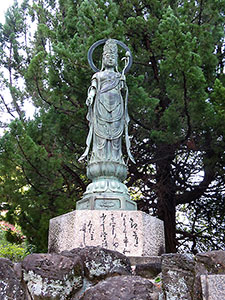for Mobilized A-bomb Victim Students

Date of completion
July 31, 1966
Established by
Bereaved families of students at 21 middle schools and girls' high schools (under Japan's old education system)
Designer :
Hoko Sunahara
Shape
The 2-meter high bronze Kannon (Goddess of Mercy) statue stands on an artificial hill comprising layers of stone.
Motive for the erection
To console the spirits of mobilized students who tragically fell victim to the atomic bomb
Epigraph
"Precious are the spirits of the young student victims, who continue to protect peace through Kannon. (Yasuo Yamamoto)"
"We can feel at peace when we imagine you sleeping in the arms of Jibo Kannon. (Reisuke Masuda)"
Noteworthy characteristics
- Statue for students at middle schools and girls' high schools
(under Japan's old education system) - From the old education system, including middle schools and girls' high schools,
to the new education system (6-3-3 system) - A Student Labor Order
This statue was erected to console the spirits of the dead students at 21 middle schools and girls' high schools (under Japan's old education system) in Hiroshima City. A plate engraved with the names of 4,000 student victims at these schools is placed inside the artificial hill, which is made of layers of stone.
In 1947 the school system was revised to equalize educational opportunities. The new system stipulated 6 years of elementary school, 3 years of junior high school and 3 years of high school. Under the new system, 3 years of junior high school were required in addition to 6 years of elementary school, and coeducation was introduced in public schools. Under the old education system, most of the students who had completed the elementary course in national schools (6-year compulsory education) would go on to attend a 2-year advanced course in national schools, 5 years of middle school (for boys) or 4 (or 5) years of girls' high school.
Under the A Student Labor Order enacted in August 1944, students in middle schools and girls' high schools (under the old school system) or students in higher education institutions were required to provide labor service in the munition industries office.
Moreover, in November 1944, to prevent the spread of fires due to air raids, over 8,000 students from advanced courses in national schools, middle schools and girls' high schools were mobilized to clean up 133 locations in Hiroshima City where buildings had been demolished to provide fire roads and firebreaks; about 6,300 of those students were killed in the atomic bombing.